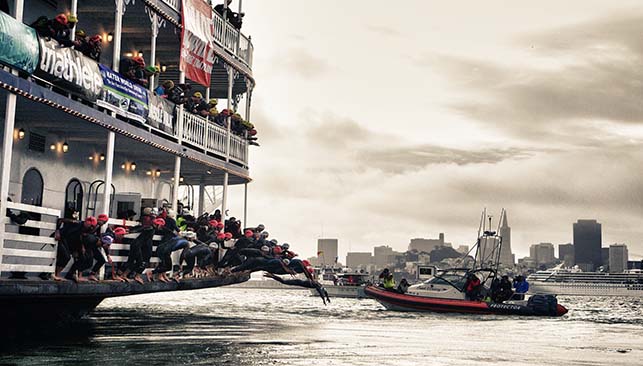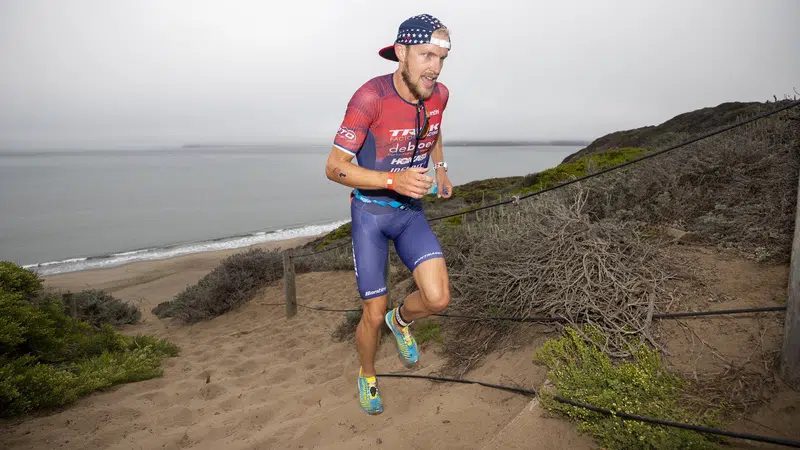What makes the Escape from Alcatraz Triathlon one of the sport’s most iconic races?
This year's 41st anniversary makes this bucket-list event one of the oldest in the sport
 Photo by:
escapefromalcatraztri.com
Photo by:
escapefromalcatraztri.com
In June 1962, prisoner Frank Lee Morris, along with fellow inmates John and Clarence Anglin (brothers) mounted a daring escape, now considered one of the greatest prison-break cold cases in history. After meticulous planning, the three climbed two barbed-wire fences and launched a homemade raft constructed of more than 50 raincoats into San Francisco Bay, escaping from the notorious Alcatraz Island prison (also known as The Rock) in northern California.
Related: Surviving the Escape – Lagerstrom and Hering take the Escape from Alcatraz
The three were never found, and the Internet abounds with conspiracy theories. Did they drift into the Pacific Ocean, unable to fight the strong currents? Did they die from hypothermia in the 12-degree water? Did a great white shark get the better of them? Only bits of the raft and a few personal effects were ever found, and no one knows whether the inmates ultimately found freedom.
Almost 60 years after Morris and the Anglin brothers cast their fate to the San Francisco Bay, 2,000 athletes from around the globe commemorate their escape each June at the Escape from Alcatraz Triathlon, one of the longest running – and most difficult – multi-sport events in the world. For 40 years, ‘EFAT’ has challenged triathletes with a cold and choppy swim from the waters near Alcatraz Island to Marina Green, followed by a hilly and technical bike course, and a run that traverses pretty much every imaginable terrain. Like the famous prison break, the race has achieved mythical status, and as hard as it was to get OUT of Alcatraz prison, it can be as tough to get IN to Escape from Alcatraz.
The toughest Olympic course in North America?
Some version of Escape from Alcatraz has been around since 1981. Local athlete Joe Oakes had raced Ironman Hawaii in 1979 (when it was in Honolulu) and brought the idea of an epic triathlon home with him. He wanted it to be shorter and more scenic, but just as arduous, as the Honolulu event. He knew that the swim should be from Alcatraz island. The bike course – originally 20 miles – included a ride across the landmark Golden Gate Bridge, and an 18-mile run on the same course used by the oldest trail race in America, the Dipsea.
By 1995, the course was tweaked into the route that exists today. The distances were adjusted to an 18-mile bike ride that stayed in San Francisco, and a shorter 8-mile run that included a climb to the base of the Golden Gate bridge, through the Presidio (a former military reservation, now a national park), and up/down hundreds of steps, including the famous sand ladder of Baker Beach.
The course can be humbling, even for the most experienced athletes. Professional triathlete Max Fennel wrote after his fourth Alcatraz last year: “This was the toughest swim I’ve done to date…at times you would get caught in a swell and just feel like you weren’t moving at all.”
Four-time Alcatraz champion Ben Kanute concurs. Interviewed for Men’s Journal, he reflected, “It’s not a course to be taken lightly: “Whether it’s swim, bike or run––there’s no settling in. It’s a lot of high-end efforts for short periods of time. You get a little bit of recovery on the downhills or sections leading to the next challenging part, then you’re pretty much hitting it again.”
Leap of faith
While the bike and run courses are extremely challenging, it’s that famous swim that cements Escape from Alcatraz on triathlete bucket lists.
Toronto-based triathlete Laura Horwitz chose Alcatraz specifically for the swim: “I wanted to face my fear of swimming in an ocean. I’ve never swam in salt water, and most exciting way to conquer that for me was to jump off a ferry and Escape from Alcatraz!”
2021 escapee Beth Hollihan of Carleton Place, ON will never forget the jump off the boat: “What a rush of anxiety and excitement!” For Dallas Jones of Port Moody, BC “The boat ride out to Alcatraz was so memorable. I sat on the floor of the boat for an hour visualizing the race and chatting with other athletes…The anticipation was electric.”
Samantha Zaino, a six-time escapee from Orlando, FL (USA) says that the swim keeps her coming back: “Every time I think it’s my last time, I end up back again. It’s a great race that always presents different challenges with the water and weather.”
On race morning, athletes board the San Francisco Belle and are treated to a circumnavigation of Alcatraz Island before the boat positions itself for the race. This gives athletes a great look at The Rock and gives them time to spot the shoreside landmarks for sighting. There are no buoys for this race. Rather, athletes use several strategic onshore landmarks to cut quickly across the channel and out of the strong currents trying to pull them out to sea.
Some years the water can be glassy smooth, but other years feature swells and chop. Athletes need to be mentally and physically prepared for those conditions. Water temperatures are typically around 14 degrees C. Wetsuits are recommended; booties and neoprene caps are allowed.
Does anyone ever “chicken out?” Out of the 1,600 athletes in 2021, only one didn’t jump.
And what about sharks? “It’s a myth” adds says open-water swimmer and coach Pedro Ordenes. Sharks don’t like the silty water of the bay, tending to stay 25km offshore in deeper water.

Run, bike, run
In the first few years of the race, organizers noticed cyclists sometimes falling right off their bikes, numbed by the cold swim, with fingers and feet that had lost feeling. A ½-mile “warm up run” was added between the swim out and transition, which gives athletes some time to shake off the cold and regain feeling in their extremities.
Assuming your fingers can now function, athletes grab bikes from transition to start the 18-mile (30 km) closed bike course, with roughly 1,600 feet (500 m) of elevation gain. The route leads cyclists up, up, and up to the foot of the Golden Gate bridge and into the Presidio, with staggering views of the Pacific Ocean. You’ll continue climbing through the monied Seagate neighborhood before dropping down to Golden Gate Park, one of the city’s largest and oldest green spaces, dating back to 1870. Aside from a mile at the start and finish, the park is the only flattish part of the bike course. Just when you have a chance to take in the beauty of the park’s trees and flower gardens, it’s time to begin the grueling climbs on the return trip. And don’t get too comfortable on the descents: Every downhill has some kind of tricky turn at the bottom.
Back in transition, you’ve got more challenges coming: Alcatraz features one ofthe most difficult run courses in the sport.
The first mile is deceptively easy, along flat road and beach trail. Athletes will enjoy views of Chrissy Beach and hundreds of pelicans and other sea birds before the hard work starts again. In the next three miles you’ll climb hundreds of rough steps, duck through a dark tunnel, shimmy up concrete ramps, and shuffle through beach paths bordered by colorful wildflowers and succulents. You’ll notice the scent of native eucalyptus trees mixed with the salt air as you once more summit the Presidio, this time on foot.

A long descent winds through the beach sage and blooming orange nasturtiums, dropping quickly down to Baker Beach, where you’ll run a mile in deep sand as waves crash next to you. To get back to the top of the cliff, you’ll encounter the much-touted sand ladder: 200 sand-filled steps with cables to help pull yourself up. Another climb at the top of the stairs leads back to the foot of the Golden Gate Bridge. From here, the last two miles are mercifully downhill, but watch your footing! Navigating those descents on tired legs can send runners tumbling.
The last flat mile gives you a chance to go hard (if you have anything left) and regroup for the finish line, adorned with fluttering flags and banners.
Getting in
At one time, everyone wanted OUT of Alcatraz. Now everyone wants in. Entry each year is determined mainly by a random drawing.
According to Jennifer Lau, VP of Action Sports Events at IMG, which produces the race, about 9,000 people apply annually for a slot (capped at 2,000). Priority is given to past participants and age-group winners. Lau says your chances at a slot through the drawing are 30% to 50%, depending on the year.
Miss out on the drawing? Charity entries are also available through a number of non-profit partners.
The random drawing entry period for the following year opens in mid September.
Getting ready to escape: Training for Alcatraz
The athlete guide calls the swim 1.5 miles (2.4km), but veteran “escapees” and local coaches warn that the distance varies every year depending on currents, tides, and the boat position.
That’s why Megan Tobin (@trimegtri) coach of the Women Tri Together program at Golden Gate Tri Club urges athletes to prepare for a longer swim: “I’ve done that swim in 30 minutes, and I’ve done it in an hour.” For the 2021 event, age groupers recorded actual swim yardage between 3200 and 3500 meters – far more than the claimed 1.5 miles.
Tobin suggests visiting San Francisco’s Aquatic Park (free) in the days leading up to the race. This protected area features the same water temperatures as out in the channel, offering a great opportunity to get a feel for the water’s salinity and chop (Tobin calls it ‘texture’). Long-time ‘escapee’ Steven Titan also touts the “AP” as a great spot for a practice swim, adding that he usually swims without a wetsuit in the days leading up to the race so the water feels comparatively warmer on race day.
Pedro Ordenes, founder of Water World Swim, which runs weekly open-water swims in San Francisco Bay, agrees that athletes should train to swim continuously for at least an hour. And to prepare for the initial shock of cold ocean water, Ordenes suggests dunking yourself in a cold spring lake, or even a cold shower: “You want to get that initial fast shock. Get your face in cold water and count to 10 – that’s the same feeling you’ll get when jumping off the boat and hitting the water.”
The Escape from Alcatraz YouTube channel features some excellent videos on sighting and the best way to attack the swim efficiently.
Lastly, race organizers introduced a Saturday aquathlon in 2021 and plan to feature it in 2022. The aquathlon is comprised of a shorter 750-yard swim (plus a 5K run) and is a great chance to get a feel for jumping off the ferry and sighting along the shore.
As for the bike and run, you’ll definitely want to train on big hills for both. And for the run, throw some varied terrain into the mix; run on trails, climb steps, and practice steep descents.
